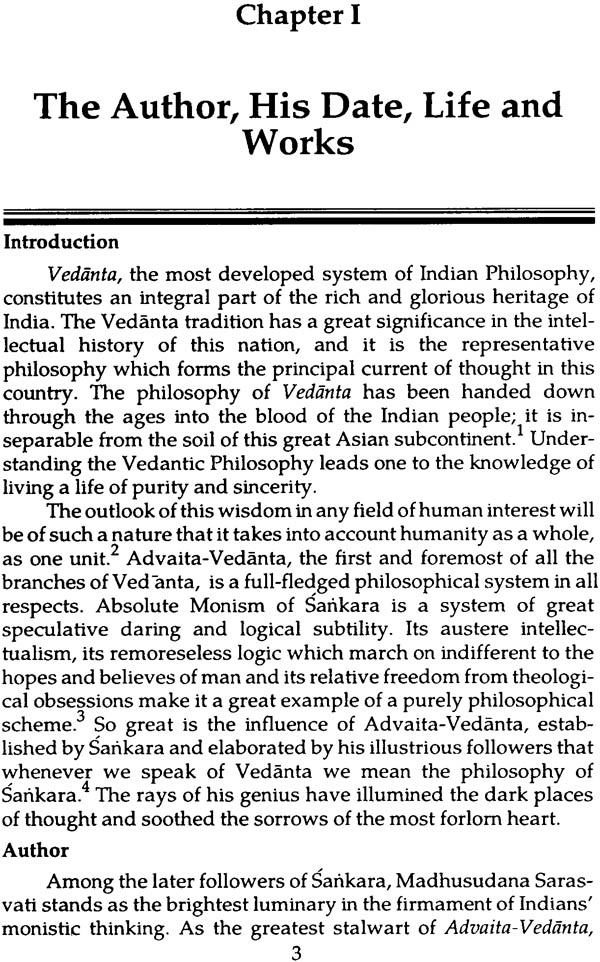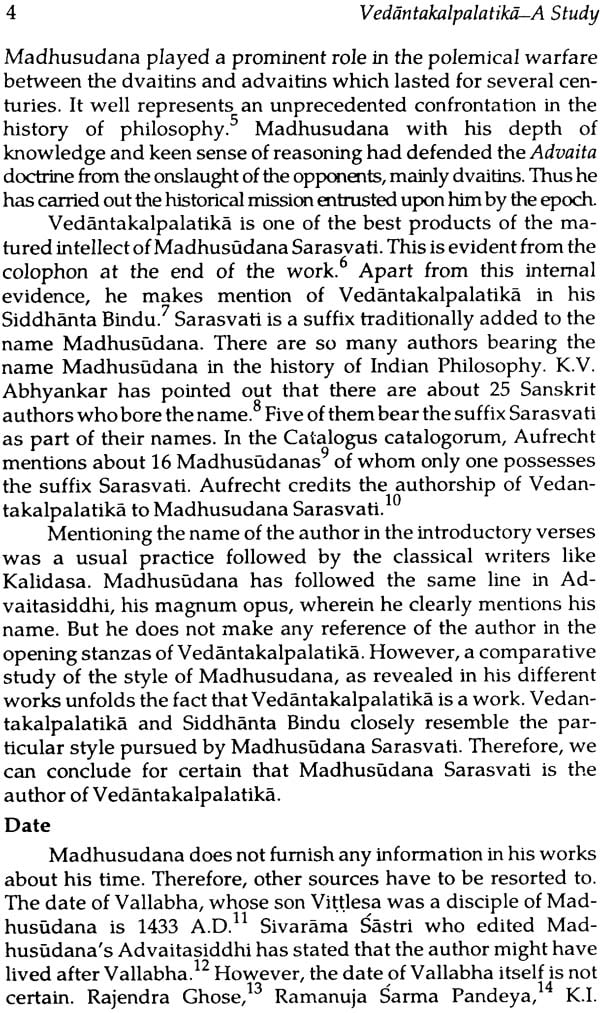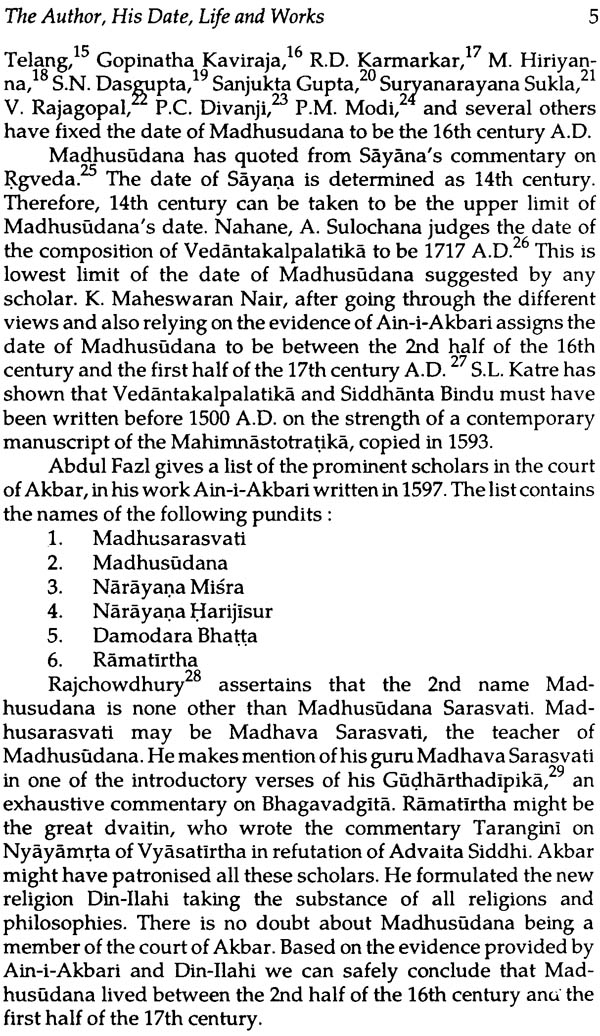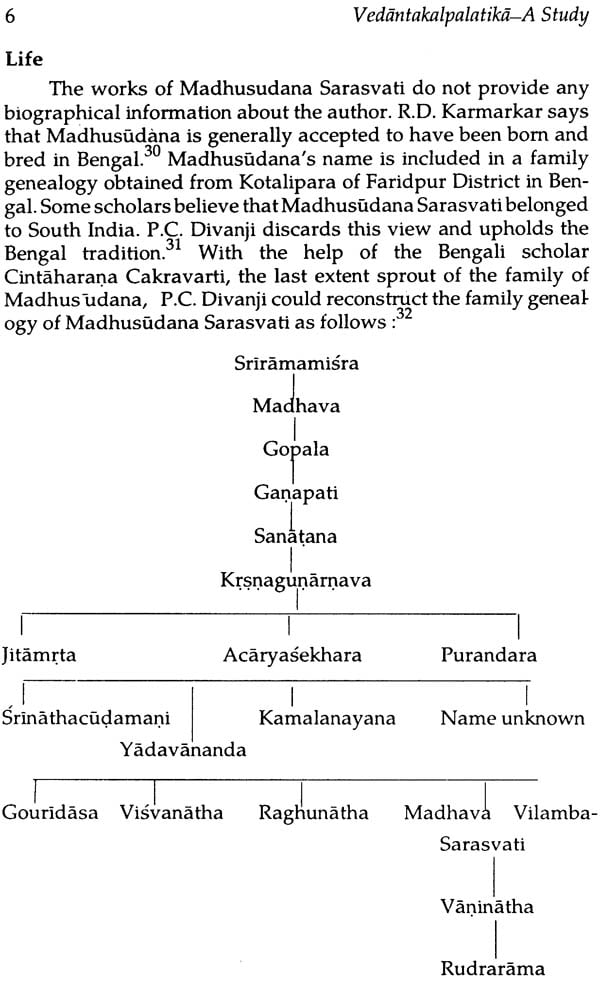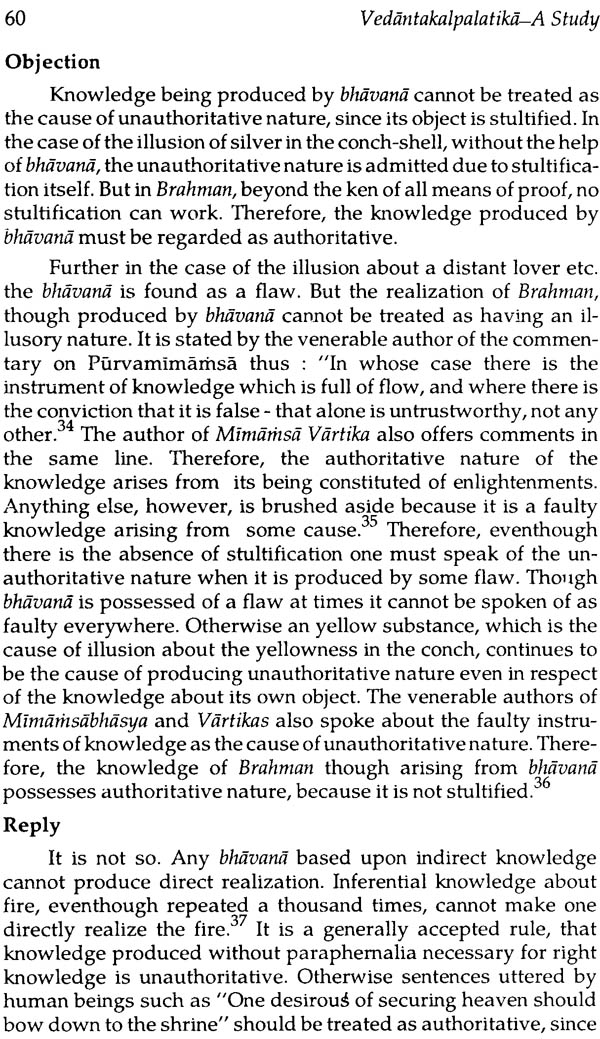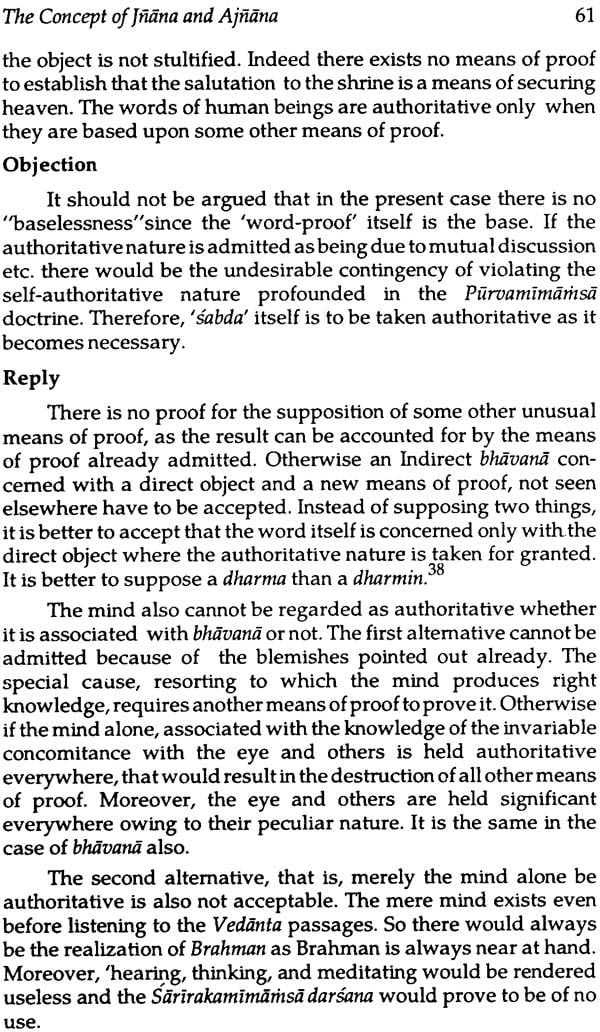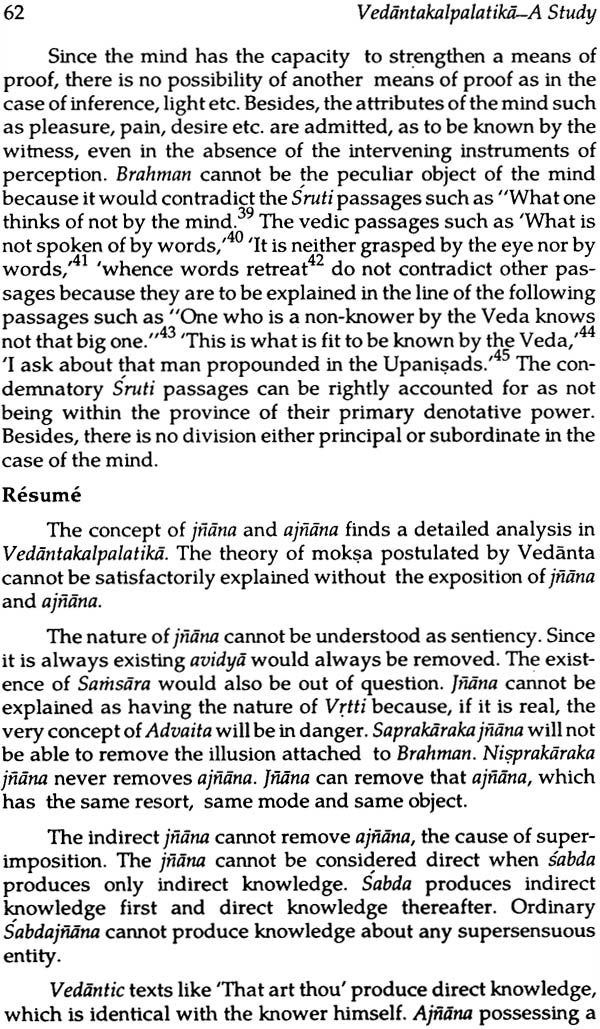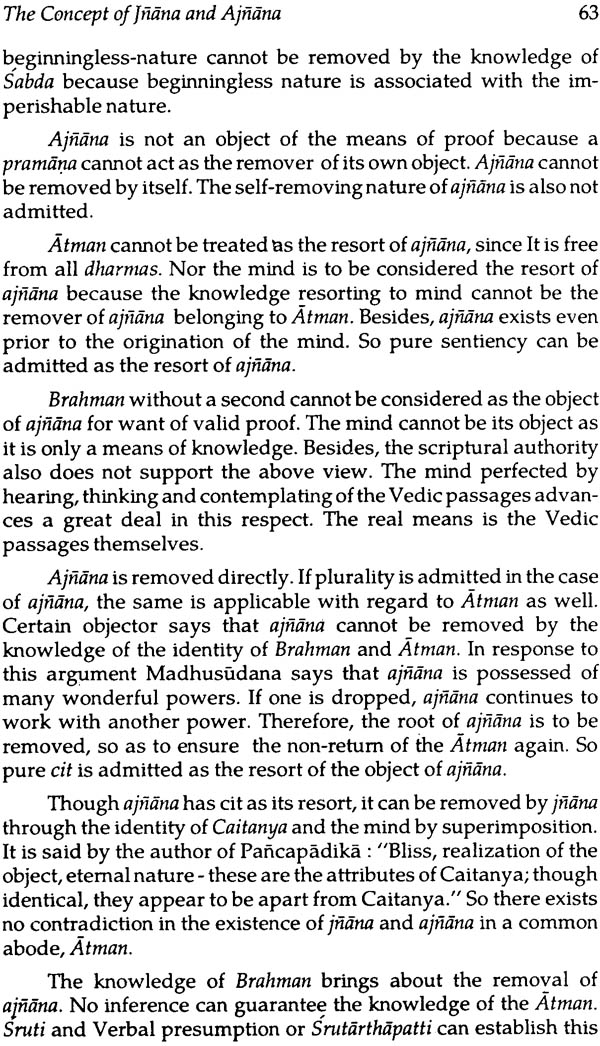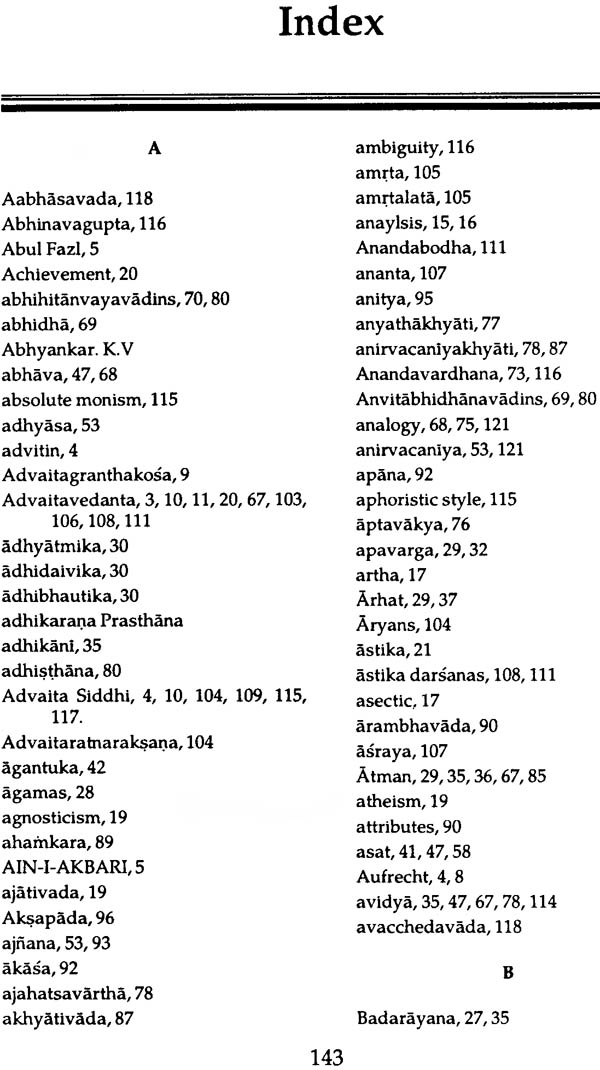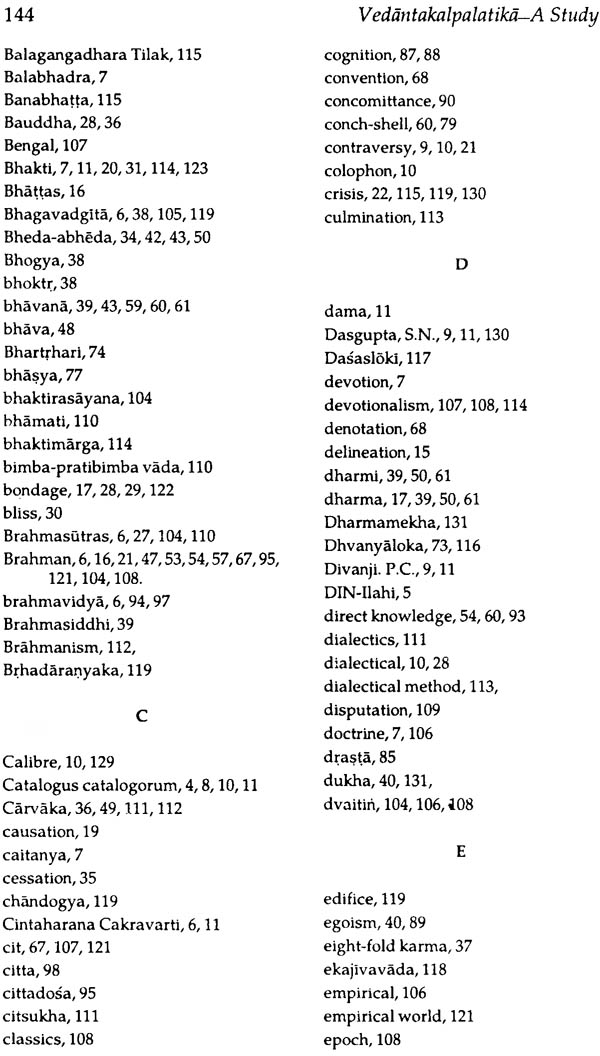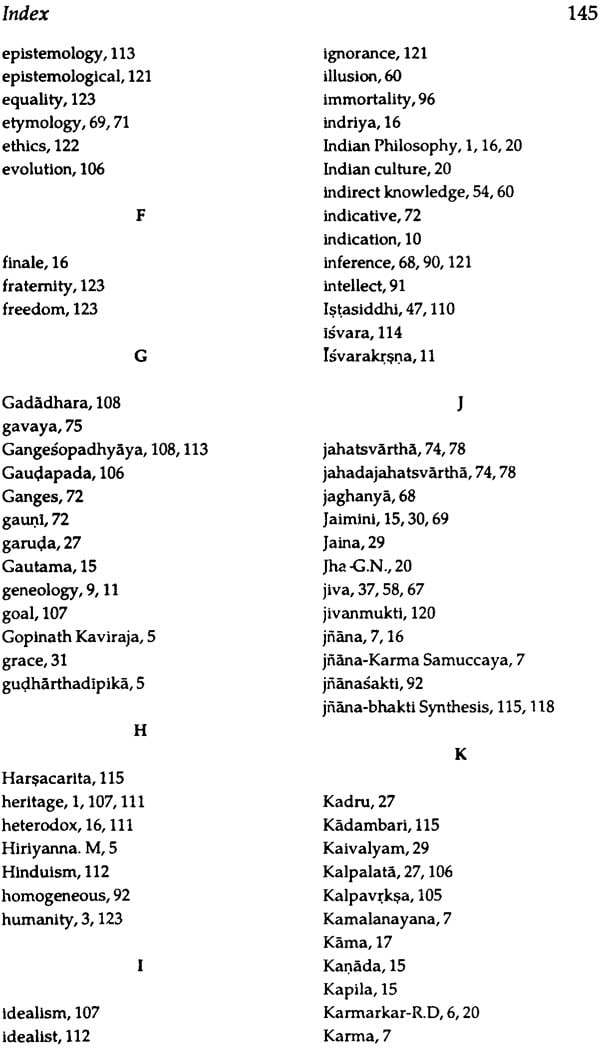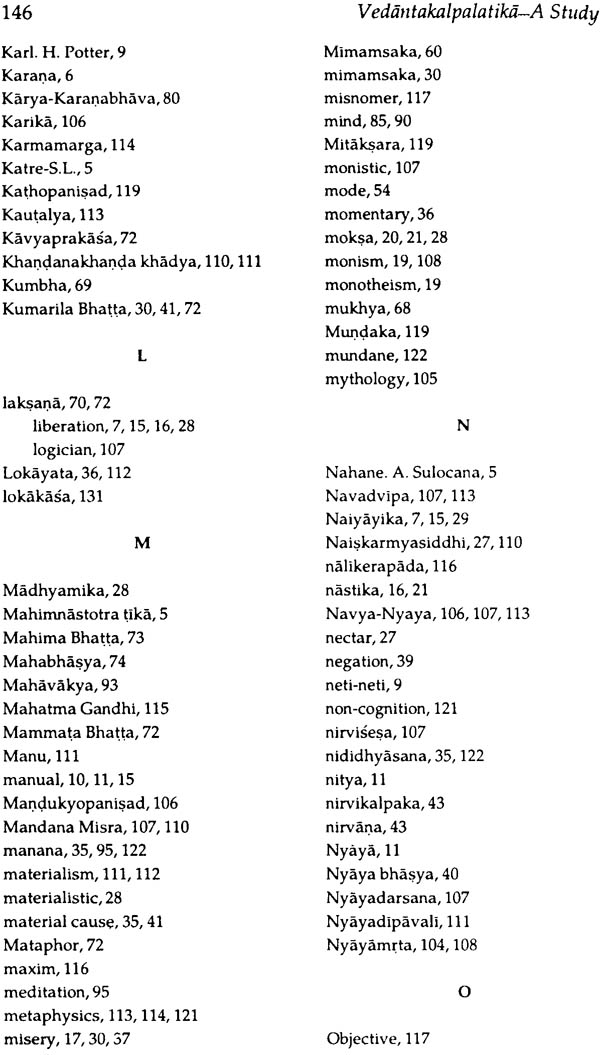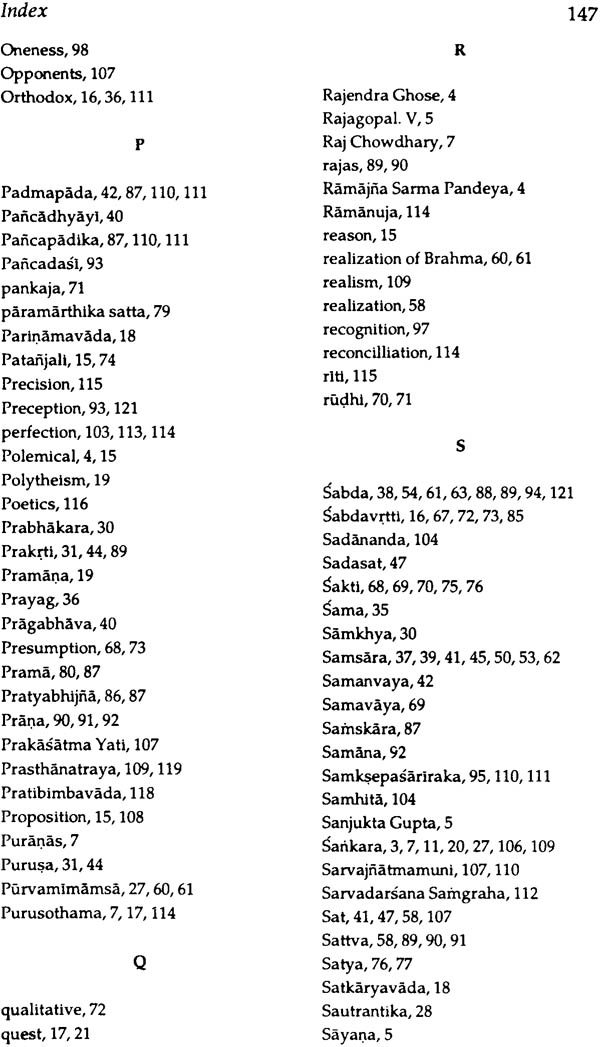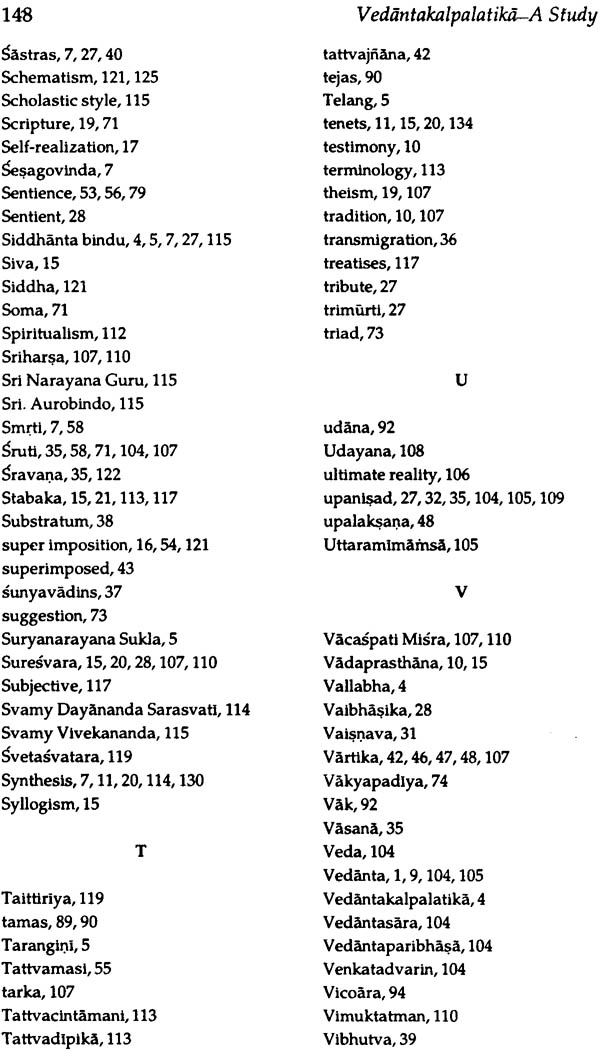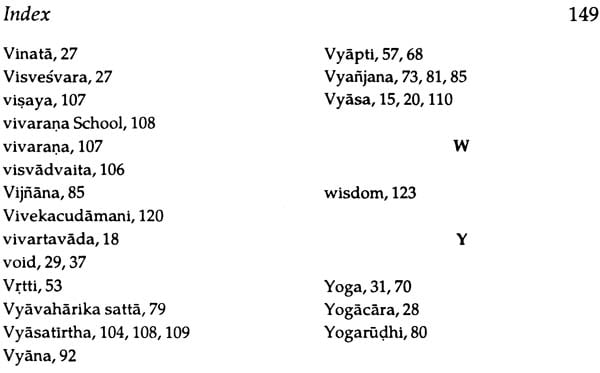
Vedantakalpalatika – A Study
Book Specification
| Item Code: | IHL221 |
| Author: | V. Sisupala Panicker |
| Publisher: | Sri Satguru Publications |
| Language: | English |
| Edition: | 1995 |
| ISBN: | 8170304369 |
| Pages: | 170 |
| Cover: | Hardcover |
| Other Details | 8.7 Inch X 5.7 Inch |
| Weight | 300 gm |
Book Description
Vedantakalpalatika is a remarkable theoretical work on Advaitavedanta by Madhusudana Saraswati. The present book contains nine chapters divided into three parts. Part I, has two chapters. The first chapter introduces the author, has date, life and works. The second chapters give a brief description of the nature, content, relevance and editions of Vedanatakalpalatika.
Part II of the book is devoted to textual examination and is divided into five chapters. In the third chapter, the different views on moksa are enumerated. The fourth chapters show how the author has established the Upanishadic view on moksa after refuting the rival theories. The theory of jnana and ajnana is discussed in details in the fifth chapter. The sixth chapter explains Brahman which is beyond the reach of all Sabdavrittis. The realization of Brahman constitutes the central topic of discussion in the seventh chapter.
Part III constitutes two chapters. All observations made on the basis of the textual study viz., general, metaphysical, epistemological, logical and ethical form the eighth chapter. The ninth chapter gives the whole study in nutshell.
Dr. V. Sisupala Panicker is presently in the Department of Sanskrit University College, Trivandrum Kerala.
Vedantakalpalatika is a remarkable theoretical treatise on Advaitavedanta, written by Madhusudana Sarasvati, the great philosopher of the sixteenth century India. Sri. V. Sisupala Panicker, a scholar of vast erudition, has made an indepth study of the work shedding light on its sub – lities hither to gone unnoticed and bringing out its deeper philosophical significance. Students and scholars alike are sure to feel idebted to Sri. Panicker for his having undertaken this challenging and thorough study and executing it with all possible care and perfection. The findings of the study bear witness that Sri. Panicker has examined the work init s depth and complexity and has in a unique and masterly manner brought out the quintessence of the work and that too in a lucid and simple style.
An enthusiastic and unfailing researcher, Sri. Panicker has judiciously applied the various aspect of research methology in the making of the thesis. Chapters are divided properly and conveniently so as to provide a comprehensive view of the text under study. Resume have been given tat the end of the each chapter. Sri. Panicker’s attempt is exemplary and extremely laudable especially in the context when research thieses are often written without caring the least to conform to the essential principles of research methodology.
Vedantakalpalatika of Madhusudana Sasasvati together with the present study – a masterly exposition and interpretation will surely inspire and interest those who are and will be in the field of knowledge, to a greater and higher level.
Sri. Satguru Publications, Delhi well deserves thanks and appreciation from all for having taken pains to publish this work in this attractive form.
Advaita Vedanta the most developed and highly esteemed system of Indian Philosophy, carries great significance, particularly, in the contemporary philosophical situation of the world. The call for unity and oneness of the entire mankind, irrespective of the barriers of nation, language, caste and creed in its message to the modern world. The Vedantic wisdom, contained in the light of the present day science and technology. Vedanta enables one to use his inner resources for the well – being of the world.
Madhusudana Sarasvati is one of the prominent philosophers in Advaita Vadanta, in the later centuries. Advaitasiddhi, his master – piece, is widely known and appreciated by the learned. But his first original work, Vedantakalpalatika, dealing mainly with the concept of liberation, is a less known work, even in philosophic circles. The present thesis is a modest attempt for a close study of Vedantakalpalatika with a view to bring out its philosophical significance.
The thesis consisting of nine chapters, is divided into three parts, excluding introduction. Part I, dealing with general information has two chapters. The first chapter introduces the author, his date, life and works. The second chapter gives a brief description of the nature, content, relevance and auditions of Vedantakalpalatika.
Part II is devoted for a textual examination. Though the original works is written in a single Stabaka, my attempt is to divide in into five chapter, based on the major topics of discussion. In the third chapter, the different views on moksa are enumerated. The fourth chapter, the different views on moksa are enumerated. The fourth chapter shows how the author has established the Upanisadic view on moksa after refuted the rival theories. The theory of jnana and ajnana is discussed in detail in the fifth chapter. The sixth chapter explains Brahman which is beyond the reach of all Sabdavrttis. The realization of Brahman constitutes the central topic of discussion in the seventh chapter.
Part III constituting of two chapters, is devoted for observations and conclusion. All observations made on the basis of the textual study viz., general, metaphysical, epistemological, logical and ethical form the eighth chapter. The thesis concludes in the ninth chapter in which the whole study is given in a nutshell.
‘Resume’ has been given at the end of each chapter.
I have made use of more than one edition of Vedantakalpalatika in the writing of the thesis. However, the text edited with English translation by R.D. Karmarkar, was of greater help to me in my studies. The page numbers of Vedantakalpalatika given in the thesis correspond to those of the above edition. In this study I have tried to bring out the practical relevance of Vedanta and Vedantakalpalatika.
I have carried out my research under the guidance of Dr. K. Maheswaran Nair, Reader, Department of Sanskrit, University of Kerala, Thiruvananthapuram. I have been greatly benefited from his unassuming scholarship and unfailing academic pursuit. I express my sincere thanks to him for his valuable suggestions and practical guidance. I express my deep sense of gratitude to Dr. N.P. Unni, Professor and Head, Department of Sanskrit, University of Kerala, for his timely help in many respects. I am also thankful to Dr. K. Vijayan, Director and Professor, Oriental Research Institute and Manuscripts Library, University of Kerala who had been a source of inspiration to me in my research activities. My thanks are also due to Prof. B. Velayudhan, Professor of English, University College, Thiruvananthapuram for his valuable suggestions in the final shaping of the thesis. I also thank other members of the staff, Department of Sanskrit, University of Kerala for the services I have received from them.
The twentieth century has witnessed revolutionary changes in the concepts and ideas pertaining to every branch of learning. No faculty of knowledge can stand isolated from another. The different peoples of the world are getting closer today than ever before owing to the fast growth and development of the systems of communication. All-pervasive schools of thought have as- sumed a new significance in the present context.
The convergence of Science and Philosophy is becoming real in an ever increasing dimension. The intimate relation between these two is more and more emphasised year after year. While special science probe into the properties of things and the natural laws that govern the material world, nature and Society, philosophy is concerned with the universe in its totality. Their possible convergence is therefore, in many ways, beneficial to the seekers of truth.
Philosophy ought to solve the intellectual problems of the day and it ought to be relevant to everyday human situation. It enlarges the ideas of awareness to become more alive, more discerning, more critical and more intelligent. Philosophy accepts the hard and hazardous task of dealing with problems not yet open to the methods of science - problems like god and evil, beau ty and ugliness, order and freedom, life and death. Every science begins as a philosophy and ends as an art; it springs up as hypothesis and flows into achievement. Philosophy aims at the hypothetical interpretation of the unknown or the inexactly known. It is the front trench in the seige of truth. Science without philosophy and perspective cannot save humanity from havoc and despair.
The universality of the tradition of philosophy is being realised by more and more nations recently. The so called parochial approach in philosophy are loosing ground. The com- plexity of the modem Society demands broadening of the base for the understanding of the truths by which men ought to live. The imperativeness of philosophy is ever-increasing, and it has now really become a confluence where the East and the West merge harmoniously.
During the recent centuries Western scholars have been con- stantly concentrating on studies pertaining to the different sys- tems of Indian philosophy. The great Indian heritage of ideas has ever been the key to the better understanding of mankind. India's contribution to the 3000 year old history of the world philosophy is in no way insignificant.
A study of Indian Philosophy should reveal the rich and varied philosophical heritage of India. Since the Vedic period a large number of philosophical views have sprung up from the various systems of thought. Indian philosophy represents an abundance of contradictory viewpoints which served as the chief motive force in its development.
The initial sprouts of Indian philosophy can be traced in the Vedas the first literary documents of human thought. The later \ portions of the Vedic literature are fully philosophical in charac- ter. These ideas contained in the Uparusads were developed into various systems of philosophy. Ideas marked for profundity and impressiveness were expounded in the important classics of original thought.
Philosophy in India is termed as darsana. In his Arthasastra, though Kautalya refers to only three darsanas viz., Samkhya, Yoga and Lokayata, Madhava in his Sarvadarsanasamgraha enumerates sixteen systems of philosophy. But only nine of them have got universal approval. They are Samkhya, Yoga, Nyaya, Vaisesika, Purvamimamsa, Uttaramimamsa, Carvaka.Jaina and Bauddha. The first six form the orthodox systems or astika darsanas while the last three constitute the heterodox systems or nastika darsanas. Later due to differences in doctrinal interpreta- tions, many schools and sub-schools came up within each sys- tem.
Uttararmmamsa or Vedanta is one of the most popular or- thodox systems of philosophy. It still carries a contemporary Significance since it has helped man in his attempt to solve the riddle of existence. Vedanta as a system of living thought and mode of conduct must strive to go beyond its existing frontiers by enlarging and re-orienting itself.
Of the three major branches of Vedanta viz., Advaita, Dvaita and Vtststadvaita, Advaita Vedanta formulated by Sankara is the most prominent one. Modem thinkers like Swamy Vivekananda also attach great importance to this philosophy. Nobody can set aside Advaita as a dead weight of the past since it possesses a living Significance. Advaita Vedanta as formulated in the Uparusads, Brahmasutras and Bhagavadgita and as ac- complished on the commentary on them by Sankara is one of the most valuable products of the human genius of its search for eternal truth.
The term Upanisad suggests Brahmavidya, destroying avidya, leads one to Brahman, having destroyed all bonds of worldly life. The Uparusads reveal a period of chaotic thought, half practical and half religious. However, Upanisads are instinct with a spirit of enquiry of mental adventure, of a thirst for finding out the truth about things.
The Sutras of Badarayana (2nd c. B.C.) represent an attempt to harmonise the Uparusadic doctrines and evolve a consistent philosophy out of them. The vagueness in Upanisadic phraseol- ogy has provided room for later commentators to formulate their theories in these cryptic Sutras. Advaita of Sankara, Dvaita of Madhva, Viststadvaita of Ramanuja and many other minor thoughts are based on these Sutras,
It is to be noted that the Bhagavatgita also served as a basic text in the formulation of various schools of Vedantic thought. The Gita furnished the one Scriptural source which could be used without violence to the accepted Brahmin methodology to draw inspiration and to arrive at justifications for social actions which were disagreeable in some way to a section of the ruling class upon whose mercy the Brahmins depended.
During 8th century A.D. Gaudapada wrote a commentary in verse on the Mandukyopanisad called Mandukyakarika. In it he tries to establish the Advaitic doctrine of identity of jiva and the Brahman. A consistent and logical philosophy of Advaita Vedanta is clearly interwoven in these karikas. However, Advaita Vedanta found its Zenith in the work of Sankara (788-820 A.D.)
Sankara wrote commentaries on the ten principal Upanisads, Brahmasutras, Bhagavadgtta and logically established Advaita. Many independent works were also written by him in order to highlight the basic propositions of Advaita Vedanta. Sankara substantiated that Brahman alone is the supreme reality and everything else including the cosmos itself, is false and is super- imposed on it by avidya. Liberation is the realization of Brahman and is to be attained by the means of knowledge.
For about three centuries Sankara's theory stood unques- tioned. But the first theistic reaction against Advaita came from Ramanuja during 12th and 13th centuries. Ramanuja also ad- mitted the falsity of the world. The sole reality according to him includes all the diversities of the material world. Brahman is the substance and the world is its attribute. Hence his system came to be called Visistadvaita. He upheld bhakti as the only means of liberation.
Madhva (13th c.) also directed a strong theistic protest against the absolutistic theory of Sankara. According to Madhva, both Brahman and the material world are real. Hence his line of thinking came to be called Dualism or Dvaita Vedanta. Madhva established the reality of the world with the help of the above mentioned triple texts. He discarded Advaita as Buddhism in disguise. He also considered bhakti as the sole means of libera- tion, which can be attained through the grace of Kesava. Thus he offered an uncompromising resistance against Advaita of Sankara.
Following Sankara, Ramanuja and Madhva several other philosophers such as Srikantha, Nimbarka, Vallabha, Bhaskara, Yadava, Baladeva also introduced their own particular schools of thought within the Vedanta system. Each such school strengthened its philosophical standpoint by opposing other schools of the Vedanta and other systems of philosophy. How- ever, these schools did not come into prominence for want of popular support. In short, it is clear that diversity and contradic- tions have always constituted the dynamic force behind the development of Indian Philosophy as well as Vedanta. At the same time, the concept of synthesis also played a prominent role in the later developments of Indian Philosophy.
In the 16th century, the influence of the bhakti movement became very decisive among the scholars and laymen alike. The absolutistic philosophy of Sarikara did not satisfy the theistic thirst of the people. Some sort of philosophic compromise was the need of the hour to uphold Absolute Monism. Madhusudana Sarasvati comes to the scene in this historical juncture. With his subtle reasoning and logtcal arguments he resisted the theistic attack on Advaita of Sankara effectively. But to keep up the absolutistic theory intact without deviating from the main track, Madhusudana boldly introduced the element of bhakti within the monistic thinking. It is not at all a surrender to the theistic schools, but a bold attempt to uphold the individuality of Advaita- Vedanta. The concept of bhakti introduced by Madhusudana is also different from the one propagated by Ramanuja, Madhva and Caitanya. It has its roots in the theoretical Advaita. Here lies the relevance of the study of Madhusudana's Philosophy, not been much explored. Vedantakalpalatika. which incorporates in itself all the cardinal doctrines of Advaita- Vedanta, especially the con- cept of liberation, is an initial work of Madhusudana Sarasvati. The Neo-logic method of presentation employed in the delineation of the topic of discussion attaches a remarkable significance to the work. Vedantakalpalatika, being a manual of Advaita-Vedanta, has paved the way for his theoretical warfare with Dvaitins and other opponents. A close study of Vedantakalpalatika becomes relevant in this context.
Besides, Madhusudana's contribution to Advaita-Vedanta deserves to be critically examined and evaluated. During the scholastic period, the polemical debates between monistic and theistic schools of philosophy continued for several centuries. But no new ideas and ideals were come out as a result of these theoretical wrangles. Here rests the importance of Madhusudana who had cut a new path within Advaita, the path of jnana-bhakti synthesis. Thus a close study of Vedantakalpalatika becomes quite relevant in the present context.
| Foreword | v | |
| Preface | vii | |
| Abbreviations | xiii | |
| Introduction | xv | |
| Part I – General | ||
| Chapter I | The Author, His Date, Life and Works | 3-13 |
| Introduction, Author, Date, Life, Works and Resume | ||
| Chapter II | Vedantakalpalatika, Its Nature, Content, Relevance and Editions | 15 – 23 |
| Nature, Contents, Relevance, Editions, Resume | ||
| Part II – Textual Examination | ||
| Chapter III | Diverse Views on Liberation | 27-34 |
| Introduction Diversity of Opinions Lokayatika Bauddha, Jaina, Vaisesika, Mimamsaka, Naiyayikas, Samkhya, Yoga, Tridandi, Pasupata & Vaisnava, Aupanisada, Resume | ||
| Chapter IV | The Upanisadic Views on Moksa Established | 25-52 |
| Introduction, Opponents’ Views refuted Carvaka System refuted, The Bauddha doctrine refuted, Jaina View refuted, Means of proof to establish Atman, The Vaisesika, Naiyayika and () Prabhakara views refuted Samkhya – Yoga views refuted Bheda – abheda views refuted The means of salvation in different darsanas, The Upanisadic views established Removal of avidya Resume’ | ||
| Chapter V | The Concept of Jnana and Ajnana | 53-66 |
| Introduction, Jnana cannot be indirect Sabda produces direct knowledge, The nature of ajnana resort of ajnana, Ajnana is removed directly, Jnana removes ajnana, Jnana is direct Resume’ | ||
| Chapter VI | Brahman – Beyond the Reach of Sabdavrttis | 67-83 |
| Introduction Function of a word, Denotative Power two-fold Divisions of Subordinate Functioning, Suggestion – another function of Sabda, Divisions of Indication, No Sabdavrtti can function in Brahman, Laksana not applicable in Brahman Power of suggestion does not work Resume’ | ||
| Chapter VII | Realization of Brahman | 85-99 |
| The mind not an instrument of moksa Mind, different from the sense-organs Sabda produces direct knowledge Sabda not similar to recognition Sabda cannot act like Indriyas, The mind, constituted of five elements, Mind and intellect Sabda not a sense – organ stages of realization Resume’ | ||
| Part III – Observations and Conclusion | ||
| Chapter VIII | Observations | 103-128 |
| (A) General | ||
| Position of Vedantakalpalatika among other works of Madhusudana Propriety of the title Vedantakalpalatika Madhusudana’ tradition Antagonists of Madhusudana, Protagonists of Madhusudana, Madhusudana’ attitude towards nastikas Method of presentation, The concept of bhakti in Madhusudana style in general Vedantakalpalatika & Siddhantabindu standard of polemics Madhusudana’s school, Indebtedness to Prasthanatraya, The Concept of Jivanmukti | ||
| (B) Metaphysical | ||
| (C) Epistemological | ||
| (D) Logical | ||
| (E) Ethical Resume’ | ||
| Chapter IX | Conclusion | 129-135 |
| Select Bibliography | 137 | |
| Index | 143 |
